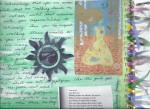
The soft, gentle place of peace and tranquility at the end of a yoga class is known to some students as the “prize” at the bottom of the box. After the stretching and the breath work, the relaxation pose at the end of class for five to ten minutes is a welcome relief. It’s also a place for something we don’t receive often enough during the day: stillness. We are so busy doing, darting, and thinking throughout the day that we forget or run out of time to find balance and do nothing but breathe. Day after day of being out of balance creates the stresses we are desperate to dissolve in our bodies and minds. The simplest way to reduce stress is to be its opposite. Stress is an active pressure on something. The physical or emotional pressure created by stress is blasted into oblivion by simply being still, not moving except for breathing for whatever time can be set aside for it.
Physical stillness is miraculous in its ability to energize our muscles and internal organs. However we’re so used to putting demands on ourselves physically and mentally, that it feels awkward to some people to be without motion so they “hold” themselves still and think this is relaxation. This is more doing. Stillness is letting go and just breathing in and out for five minutes and nothing else. It works better and achieves a better overall result to lie down, but it’s possible to let go while sitting up. But that’s the challenge of meditation isn’t? To meet the urge to do something with just being. So if life feels out of balance, it probably is. When we try to find balance with the practice of stillness, remember that there are two ways to achieve the stillness. We can grip something so hard it is still, or we can let go of everything until the bliss of just being pervades us on the deepest of levels. This is stillness.
How do you achieve stillness?
There are five primary areas of practice to the Writer Wellness plan. Every other week I will post an idea for relaxation (Monday Meditation,) creative play (Tuesday Tickle,) fitness and exercise (Wednesday Workout,) journaling and misc. (Thursday Thought,) and nutrition (Friday Feast.)
 Meanwhile, remember to look for a digital or print copy of Writer Wellness, A Writer’s Path to Health and Creativity at Who Dares Wins Publishing, http://whodareswinspublishing.com.
Meanwhile, remember to look for a digital or print copy of Writer Wellness, A Writer’s Path to Health and Creativity at Who Dares Wins Publishing, http://whodareswinspublishing.com.
And check out these great blogs for ideas to keep your writing and publishing healthy and prosperous.
http://writeitforward.wordpress.com/ Bob Mayer
http://jenniholbrooktalty.wordpress.com/ Jenni Holbrook
http://warriorwriters.wordpress.com/ Kristen Lamb
http://inspiration4writers.blogspot.com/ Inspiration for Writers, Inc.
http://pentopublish.blogspot.com/ Natalie Markey
http://amyshojai.com Amy Shojai
Check out my new website Joy E. Held
Have you subscribed to this Writer Wellness blog yet? Get email updates when a new post is added. Click “subscribe” and leave your email. That’s it and thanks in advance!
Be well, write well



